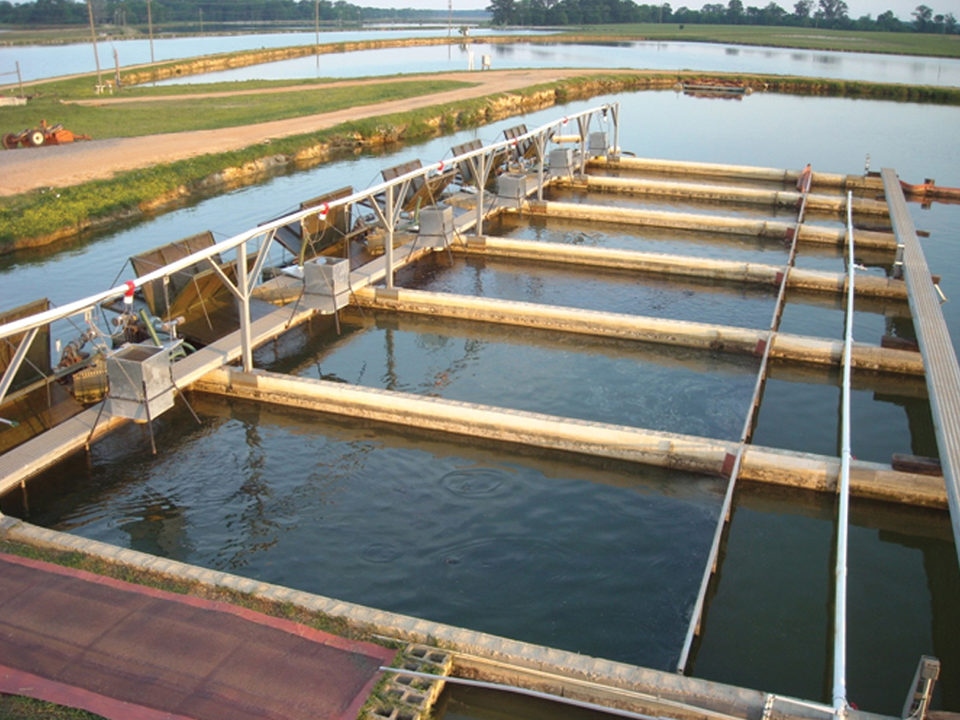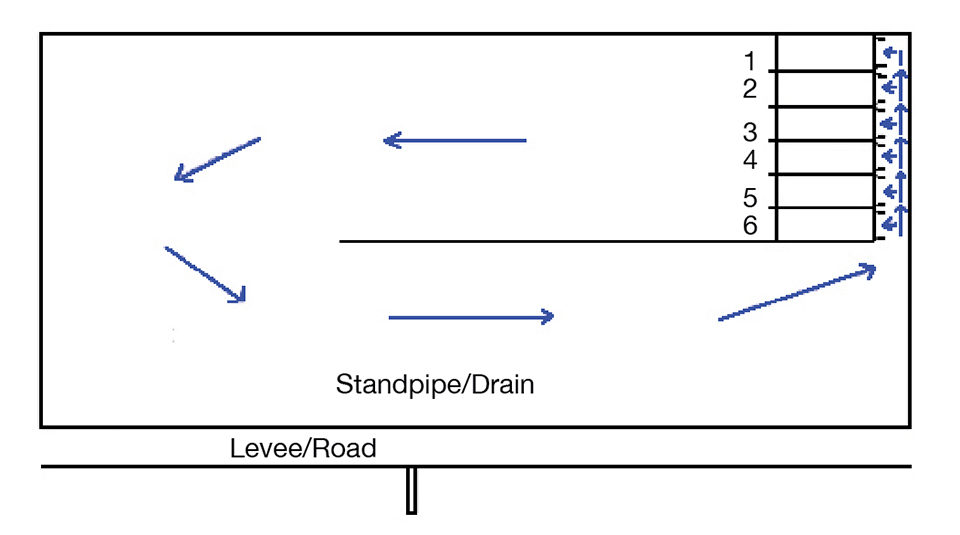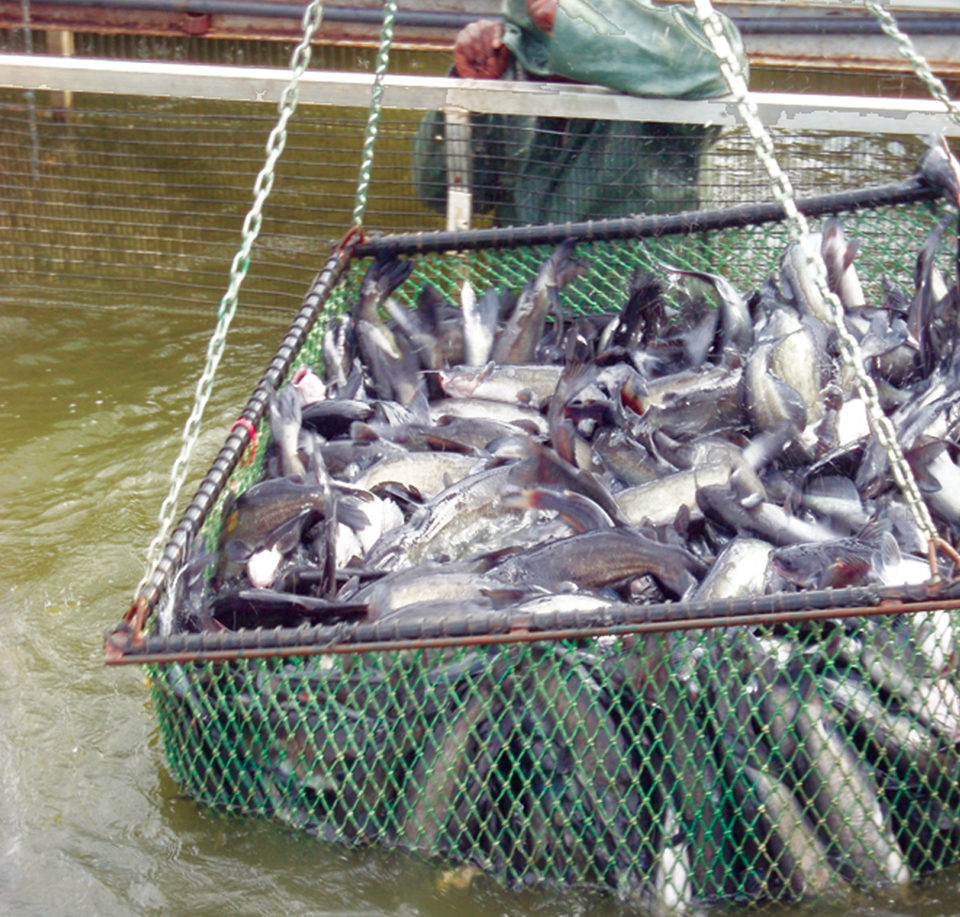Hybrid catfish perform slightly better than channel catfish

Catfish farming is the largest segment of the United States aquaculture industry with annual production of over 231,000 metric tons (MT) of food-size catfish worth an estimated $410 million in 2008. Due to increased feed prices and energy costs, and international seafood competition, production of channel catfish is becoming less attractive as a farm enterprise. Since 2002, the U.S. catfish industry has seen a 25 percent decrease in pond area and 31 percent decrease in the number of catfish operations.
In the United States, catfish are commonly cultured in levee ponds or hillside watershed ponds, and harvested by seine. This technique requires a large amount of land and labor associated with the overall yield. Additionally, in the continuous multiple-batch system, harvests of large ponds often do not capture all larger fish – leading to production and economic inefficiencies, especially relative to feed conversion. Therefore, more-efficient production technologies for raising channel catfish are needed to improve economic viability.

In-pond raceway system
Auburn University’s Department of Fisheries and Allied Aquacultures has performed research to improve the economic efficiency and profitability of catfish production by demonstrating the ability of a fixed in-pond raceway system (IPRS) to achieve high levels of feed performance and fish survival, and lower production costs in a commercial farm setting.
A commercial-scale modified IPRS was built in 2007 into an existing 2.43-hectare (ha) catfish pond with average depth of 1.7 meters at a farm in western Alabama, USA. The IPRS had six 46-cubic-meter production raceway cells constructed side by side of concrete blocks on a reinforced concrete pad.
Each raceway consisted of three separate components: an area with a slowly rotating paddlewheel, a fish culture area and a waste-settling zone. Installed on the upstream ends of the raceways, the paddlewheels allowed water exchange as frequently as every five minutes. A 1.12-kW regenerative blower was utilized in each raceway for supplemental and/or emergency aeration.
A central baffle was installed in the center of the pond to aid in water circulation around the pond.

Catfish production
Channel catfish and hybrid catfish fingerlings were obtained from commercial suppliers and three raceways were stocked with each fish. Upon arrival from the hatcheries, fingerlings were sampled to screen for diseases and estimate initial weights. Once the initial inventory and fingerling acclimation were complete, raceways were stocked at densities ranging 17.67-118.04 kg fish per cubic meter. Individual fish weights ranged 58.9 to 417.3 grams (Table 1).
Brown, Stocking and harvest densities, Table 1
| Fish Stocked (fish/m3) | Stocking Density (kg/m3) | Harvest Density (kg/m3) |
|
|---|---|---|---|
| Channel Catfish | |||
| Raceway 1b | 300 | 17.67 | 54.74 |
| Raceway 2 | 256 | 45.31 | 143.63 |
| Raceway 5 | 655 | 92.06 | 198.59 |
| Hybrid Catfish | |||
| Raceway 1a | 253 | 105.46 | 158.24 |
| Raceway 3 | 183 | 116.72 | 141.17 |
| Raceway 4b | 256 | 118.04 | 175.70 |
| Raceway 6 | 556 | 34.69 | 214.25 |
The decision to stock wide ranges of densities and individual sizes was made to simulate an “in-progress” staggered stocking and harvest production method. This aided in maintaining a balanced production system by keeping the overall fish biomass below the total carrying capacity of the pond and would provide a more frequent cash flow.
The duration of growout ranged between 89 and 250 days depending on initial catfish stocking size. The catfish were offered a commercial 32 percent-protein floating feed multiple times daily based on biomass, water temperature and fish size. General water quality parameters were measured daily and remained within acceptable ranges for catfish production.
Co-culture
A variety of fish were stocked outside the raceways to assist with water quality management issues and produce other marketable fish as a farm diversification measure to reduce marketing risks. Paddlefish with an average individual weight of 0.33 kg were stocked at a rate of 289/ha. Tilapia broodfish with an average weight of 0.23 kg were sexed and stocked at a rate of approximately 12 breeding pairs/ha).
All catfish were sampled monthly to determine average size and total biomass in each raceway. Individual fish length and weight measurements from each raceway were used to determine average length and size distribution for each subgroup.
Results
Catfish were harvested throughout the study as they reached marketable sizes. A total 49,808 kg of catfish (20,510 kg/ha) were harvested with an 83.7 percent survival rate. An additional 3,951 kg of tilapia and 2,401 kg of paddlefish were harvested.
Paddlefish survival was 85.9 percent, whereas tilapia continued to naturally spawn throughout the production season. The cost of production for producing channel and hybrid catfish was U.S. $1.57/kg but was reduced to $1.39/kg when the value of the co-cultured species was included (Table 2).
Brown, IPRS production and economic results, Table 2
| Total Weight Stocked (kg) | Total Weight Harvested (kg) | Production (kg/ha)¹ | Survival (%) | Feed- Conversion Ratio² | Receipts (U.S. $/kg) | Cost of Production (U.S. $/kg) | Estimated Net Returns (U.S. $/kg) |
|
|---|---|---|---|---|---|---|---|---|
| Channel, hybrid catfish | 18,467 | 49,808 | 12,908 | 83.7 | 1.50 | 1.63 | 1.57 | 0.06 |
| Tilapia | 14 | 3,951 | 1,622 | 100.0 | – | 6.61 | 0.12 | 6.50 |
| Paddlefish | 229 | 2,401 | 895 | 85.9 | – | 5.51 | 0.44 | 5.07 |
| Total | 18,710 | 56,160 | 15,424 | 2.15 | 1.39 | 0.76 | ||
| Projected Models | ||||||||
| Channel catfish + co-cultured fish | 6,910 | 42,753 | 14,762 | 78.0 | 1.74 | 2.37 | 1.46 | 0.91 |
| Hybrid catfish + co-cultured fish | 10,378 | 69,566 | 24,376 | 89.1 | 1.36 | 2.11 | 1.17 | 0.94 |
¹ Production is based on the 2.43-ha pond area, not the catfish raceway production area.
² FCR cannot be calculated for tilapia and paddlefish because no feed was applied.
Potential production capabilities for the channel or hybrid catfish in the IPRS were developed from actual production data from field trials. Data from three raceways of either channel or hybrid catfish were used to extrapolate production results to six raceways for comparative purposes. Production data used in the simulated models included the average performance of each catfish species.
The projected production capabilities using only channel or hybrid catfish are also shown in Table 2. Channel catfish had a lower average survival rate than hybrid catfish. The average feed-conversion ratios for channel catfish and hybrid catfish were 1.74 and 1.36, respectively.
From these trials, it was evident that hybrid catfish performed better in the IPRS than the channel catfish, as evidenced by the hybrid cost of production of U.S. $1.17/kg compared to the channel catfish cost of $1.46/kg). Additionally, the IPRS produced more catfish per kilowatt-hour of electricity used than in a traditional pond using 5.5 kW/ha of aeration (Table 3).
Brown, Power efficiency comparison, Table 3
| IPRS | Traditional Farm (5.5 kW/ha) | |
|---|---|---|
| Catfish produced (kg/ha) | 12,908 | 10,088 |
| Power usage (kW-h) | 24,201 | 23,685 |
| Efficiency (kg/ha/kW-h) | 0.533 | 0.426 |
Perspectives
IPRS improvements in survival, feed efficiency, disease management and overall production have increased yields, reduced unit production costs and improved enterprise profitability over traditional multiple-batch pond production systems for catfish.
This system demonstrates an efficient means of producing a higher quantity of catfish along with other co-culture species with improved survival and reduced feed conversion compared to traditional methods. However, a three- to five-year continual production demonstration is needed to verify initial research findings. As the IPRS and associated management are further refined, it is expected that production efficiency will improve and construction costs will decline even more.
(Editor’s Note: This article was originally published in the July/August 2010 print edition of the Global Aquaculture Advocate.)
Now that you've finished reading the article ...
… we hope you’ll consider supporting our mission to document the evolution of the global aquaculture industry and share our vast network of contributors’ expansive knowledge every week.
By becoming a Global Seafood Alliance member, you’re ensuring that all of the pre-competitive work we do through member benefits, resources and events can continue. Individual membership costs just $50 a year. GSA individual and corporate members receive complimentary access to a series of GOAL virtual events beginning in April. Join now.
Not a GSA member? Join us.
Authors
-
Travis W. Brown
Department of Fisheries and Allied Aquacultures
203 Swingle Hall
Auburn University, Alabama 36849-5419 USA -
Jesse A. Chappell, Ph.D.
Department of Fisheries and Allied Aquacultures
203 Swingle Hall
Auburn University, Alabama 36849-5419 USA -
Terry R. Hanson, Ph.D.
Department of Fisheries and Allied Aquacultures
203 Swingle Hall
Auburn University, Alabama 36849-5419 USA[117,100,101,46,110,114,117,98,117,97,64,114,116,110,111,115,110,97,104]
Tagged With
Related Posts

Responsibility
Advances in super-intensive, zero-exchange shrimp raceways
Research at the Texas AgriLife Research Mariculture Laboratory is investigating ways to improve the economic viability of super-intensive raceways for shrimp production.

Health & Welfare
A holistic management approach to EMS
Early Mortality Syndrome has devastated farmed shrimp in Asia and Latin America. With better understanding of the pathogen and the development and improvement of novel strategies, shrimp farmers are now able to better manage the disease.

Intelligence
A land grab for salmon (and shrimp) in upstate New York
The operators of Hudson Valley Fish Farm see their inland locale as a pilot to prove that land-based fish farming, located in close proximity to major metropolitan markets, can be successful.

Responsibility
A look at unit processes in RAS systems
The ability to maintain adequate oxygen levels can be a limiting factor in carrying capacities for RAS. The amount of oxygen required is largely dictated by the feed rate and length of time waste solids remain within the systems.


